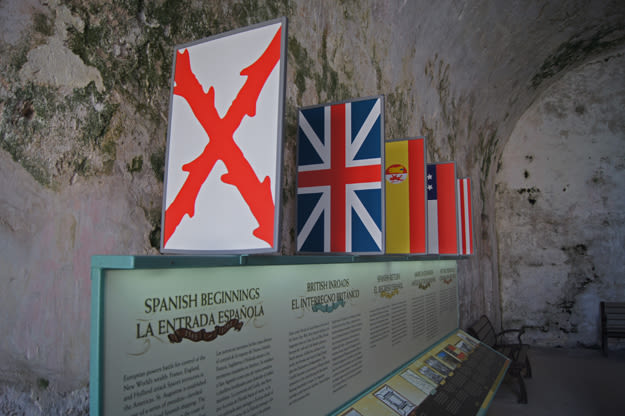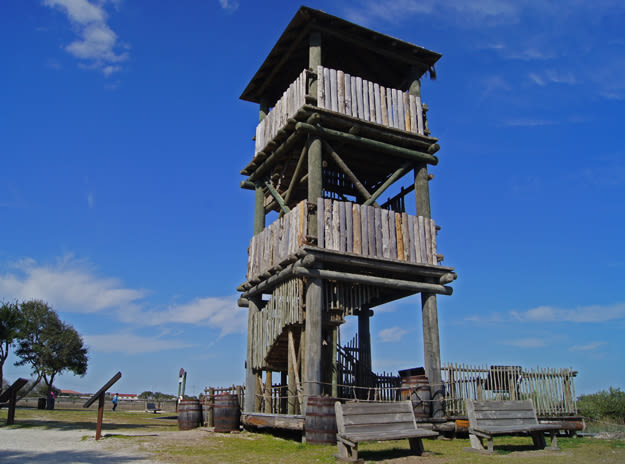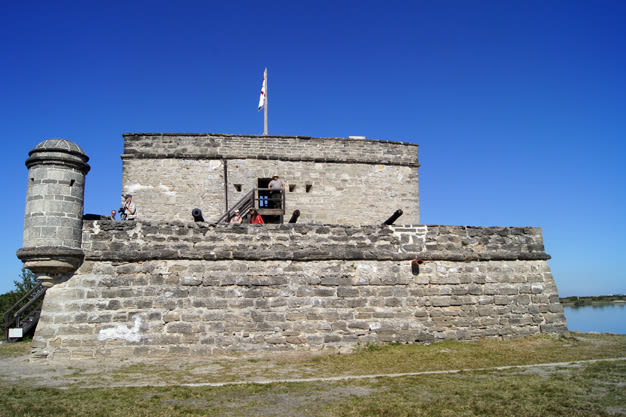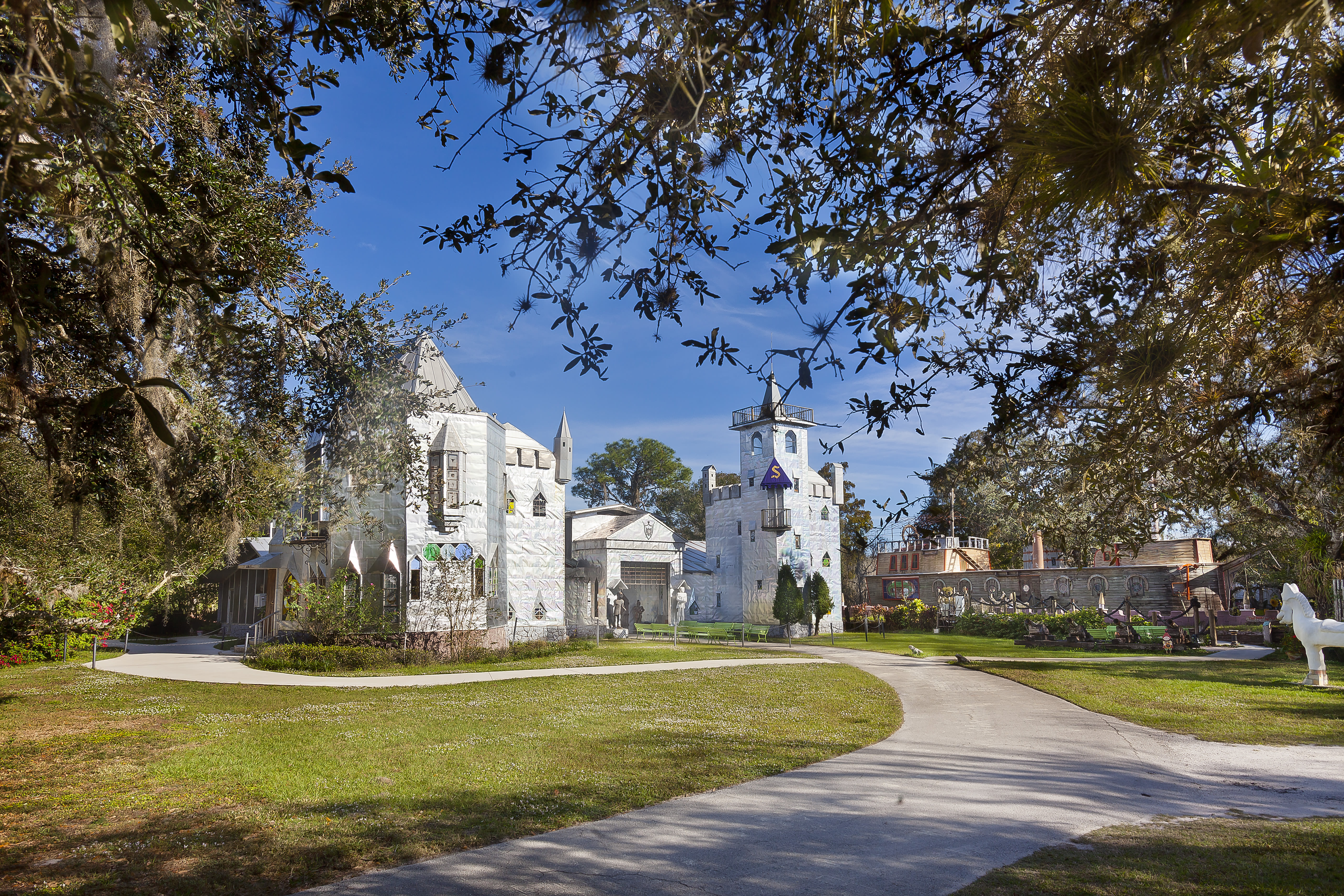Your Summer Guide to St. Augustine

St. Augustine's Bridge of Lions
Midway between Daytona Beach and Jacksonville is St. Augustine, the oldest continuous European settlement in the United States. Embraced by a community that celebrates its historical roots, St. Augustine welcomes visitors to experience Florida’s (and America’s) fascinating past.

Flags representing St. Augustine's historical occupations
St. Augustine’s rich history is well-chronicled by the landmarks that bear witness to six historical occupations, from the First Spanish Period in 1565 to the Confederate Period in 1861. Castillo de San Marcos, Fort Matanzas and the fabled Fountain of Youth are a few of many historical attractions that bring history to life and illuminate the city’s captivating, richly layered past.
It’s easy to become absorbed by St. Augustine, whether visiting an historic landmark or walking the narrow stone streets of the historical downtown. No matter whom you encounter--a tour guide, restaurant server, historian or even a character re-enacting the past--virtually everyone knows their local history and will gladly share their version.
Florida was once a major area of conflict as European nations fought to control the New World. The Spanish, French, and British battled for the right to control the sea channels that carried treasures and precious cargo along the Gulf Stream past the Florida shores.

Fountain of Youth Lookout Tower
To experience St. Augustine history, consider starting at the Fountain of Youth. While the name refers to a place of legend, the park itself yields a glimpse into the real St. Augustine. Not far from Old Town, the Fountain of Youth Archaeological Park, one of Florida’s oldest attractions, is tucked away in a quiet neighborhood. With a shady “Old Florida” arched entrance, this 15-acre waterfront property is the original location of St. Augustine’s first settlement.

Castillo de San Marcos overlooks the Matanzas Bay
Soon you’ll want to make your way to the Castillo de San Marcos, undoubtedly the most popular attraction in St. Augustine. The oldest masonry fort in the United States, completed in 1695, was used to protect treasure fleets, the harbor and local inhabitants from pirate invasions. Its strategic position on the west bank of Matanzas Bay protected the harbor entrance as well as land attacks from the north.
This year is the 100th anniversary of the National Park Service, and the fort will have extended hours and candlelight tours leading up to the August 25th anniversary when admission will be free to the public.

Fort Matanzas was designed to protect the city from invaders sailing through the Matanzas Inlet
Fourteen miles south of the Castillo de San Marcos, on the Intracoastal Waterway, is another national park treasure, Fort Matanzas. Also built by the Spanish, but after Castillo de San Marcos, this fort was designed to protect the city from invaders sailing through the Matanzas Inlet. Built by convicts, slaves and soldiers, the fort towers 50 feet high, with a 30-foot tower and coquina walls. It was a remote outpost where men served duty one month at a time.
Back in town, the Colonial Quarter provides a glimpse of St. Augustine when it was a remote outpost of the Spanish Empire. Throughout the Quarter, costumed interpreters recreate St. Augustine’s past, illustrating the life of soldiers and their families in the 16th, 17th and 18th centuries through a soldier’s eyes. You will see a home, blacksmith and leatherwork shops and musket drills, and you can climb a watchtower overlooking the city.
On St. George Street in Old Town you’ll find the Oldest Wooden Schoolhouse in the U.S., dating to the 1700s. Nearby restaurants and cafes add old-time flavor and a chance to sit and relax amidst the engaging history. The Oldest House is another historic landmark, also dated to the 1700s and located south of King Street near the Marina area.

Flagler College, once Henry Flagler's Hotel Ponce de Leon
Henry Flagler visited St. Augustine in 1883 and recognized the need for a luxurious hotel. He built two, becoming one of the earliest Florida tourism promoters. And, of course, it was his railroad that brought people to them. He also was a major patron of the arts, and encouraged artists to stay at the lavish hotel, providing them with art studios and access to wealthy patrons. Louis Tiffany, famed for his stained glass windows, stayed at the hotel, along with other renowned painters. Flagler College’s Legacy Tour highlights its architectural heritage and is considered one of the best in St. Augustine.
Across the street from the college, Flagler also built the Hotel Alcazar as an extension of the Hotel Ponce de Leon. Here guests could enjoy Turkish baths and an indoor swimming pool. Now known as the Lightner Museum, it showcases fine and decorative 19th century art, furnishings, and relics of the Gilded Age.
The Lightner Museum will showcase the American Parks Encore Exhibit from June 10th through August 31st exhibiting 50 images from America’s Parks including works from the Find Your Park Plein Air. Selected artist renderings of the area and landmarks such as the Castillo de San Marcos and Fort Matanzas will be included.

St. Augustine is an art haven
St. Augustine has been a haven for artists ever since Flagler’s day. When the 1920s-depression era slowed tourism, the local art association rallied to promote the town’s European charm to both artists and tourists. The city remains an arts town, with visual, performing and literary arts evidenced in its wide range of museums, performances and festivals.

The St. Augustine Distillery and Ice House Restaurant is a St. Augustine favorite
Dining choices in St. Augustine range from fine restaurants to Old Florida eateries, sidewalk cafés and eclectic bistros. Considering the area’s cultural diversity, many of the area’s restaurants feature culturally influenced selections, fresh-caught seafood and locally grown produce. The destination’s signature dishes often include the local and distinctive datil pepper. Its heat and intense flavor are evident in chowders, stews, and various Spanish tapas.
St. Augustine is also filled with historic inns. The elegant Victorian Cedar House Inn is within walking distance to most everything. Relax with a glass of wine while lounging on the southern style veranda (and don’t miss the blueberry cheesecake French toast for breakfast). Another favorite is St. Augustine’s oldest inn, the charming St. Francis Inn.
To receive Authentic Florida's free enewsletter, featuring travel and living updates, delivered weekly, sign up on the home page Authentic Florida, voted Blog of the Year and Best Travel Blog at the Orlando Sunshine Awards.



